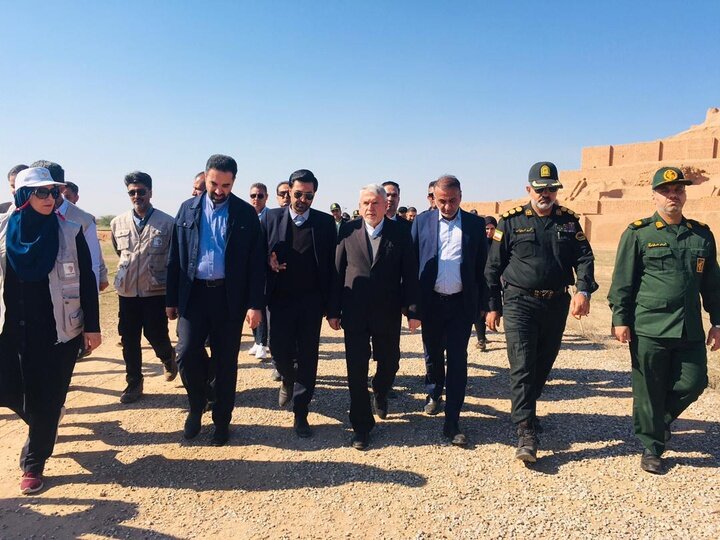Tourism minister visits Susa highlights its glorious World Heritage
Tourism minister visits Susa, highlights its ‘glorious’ World Heritage
TEHRAN - On Wednesday, Iran’s Minister of Cultural Heritage, Tourism, and Handicrafts, Seyyed Reza Salehi-Amiri, visited the UNESCO-registered ancient city of Susa in Khuzestan province. During his visit, he emphasized the city’s universal significance and its vital role in Iranian and global history.

Attending a meeting held at the county governor’s office, Salehi-Amiri described Susa as “the land of mysteries and wonders.” He noted that Susa is not merely an Iranian treasure but a heritage site belonging to all humanity.
“Susa has, for thousands of years, been a symbol of unity in its long history,” he stated.
The minister highlighted Susa’s historical and cultural importance, calling it a cornerstone of Iranian identity and civilization. “Susa is more than just a city; it is a part of who we are. Every excavation in this area reveals a new mystery, reaffirming its title as the land of secrets,” Salehi-Amiri said.
He also stressed the need to reintroduce Susa’s rich history to both [younger] Iranians and the global community. “Iran is proud of Susa, and this pride should be instilled in every citizen, especially students. It’s imperative that educational materials include Susa’s historical significance,” he said, urging cultural and educational institutions to promote the site to younger generations.
Elsewhere in his remarks, called for greater efforts by media, educators, and cultural organizations to enhance the city’s global image. “The beauty and cultural wealth of Susa have not been adequately presented to Iranians or the world.”
In his remarks, the minister also underscored the unity of Iranian identity and Islamic values. “Iran’s sacred history integrates pre-Islamic and Islamic cultural heritage. There is no contradiction between them, as both strengthen and complement each other,” he said.
The minister highlighted Susa’s potential to become a major tourist hub, emphasizing the need to improve infrastructure in the area. He assured that the ministry will prioritize addressing the city’s needs.
Earlier this month, Omid Sabripour, the governor of Shush, called for renewed archaeological efforts in the ancient city of Susa, where, according to him, less than 10% of its archaeological treasures have been excavated.
“We need to leverage UNESCO funding and international cooperation to initiate new archaeological campaigns in Susa,” Sabripour stated. “The city’s immense historical, religious, natural, and industrial heritage, along with its significant role in the Sacred Defense (the eight-year Iran-Iraq war), offers enormous potential for tourism development, which has remained largely untapped.”
Moreover, on the same day, Salehi-Amiri toured the UNESCO-listed Tchogha Zanbil, which is a magnificent ziggurat near Susa.
A global treasure
Located in southwestern Iran, approximately 115 kilometers northwest of Ahvaz, Susa is one of the oldest and most significant archaeological sites in the world.
Registered as a UNESCO World Heritage site in 2015, Susa boasts a complex of archaeological mounds on the eastern bank of the Shavur River, alongside Ardeshir’s palace on the opposite bank. These layers of urban settlements chronicle a continuous history from the late 5th millennium BC to the 13th century CE.
The site’s architectural relics include administrative, residential, and palatial structures, offering a glimpse into the Elamite, Persian, and Parthian cultures, many elements of which have vanished over time. Susa was a winter residence for Persian kings following its capture by Cyrus the Great in 538 or 539 BC, marking its integration into the Persian Empire.
A wealth of archaeological finds
Archaeological excavations in Susa have uncovered a treasure trove of artifacts, including pottery, bronze items, ornamental objects, and clay tablets. Despite its historical and cultural wealth, much of Susa remains unexplored, highlighting the urgent need for renewed archaeological initiatives.
Gateway to must-see destinations
Susa also serves as a portal to several prominent landmarks, including the UNESCO-listed ziggurat of Tchogha Zanbil, the Achaemenid Apadana Castle, Shush Castle (Akropol), and the Prophet Daniel Shrine. Additionally, the Museum of Susa and the Haft Tapeh archaeological site attract history enthusiasts from around the globe.
With such unparalleled historical significance and cultural assets, local authorities hope that intensified excavation efforts and better promotion will transform Susa into a leading global destination for heritage tourism.
AM
source: tehrantimes.com